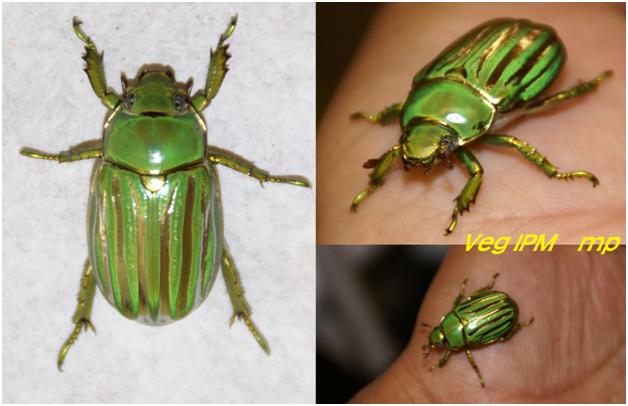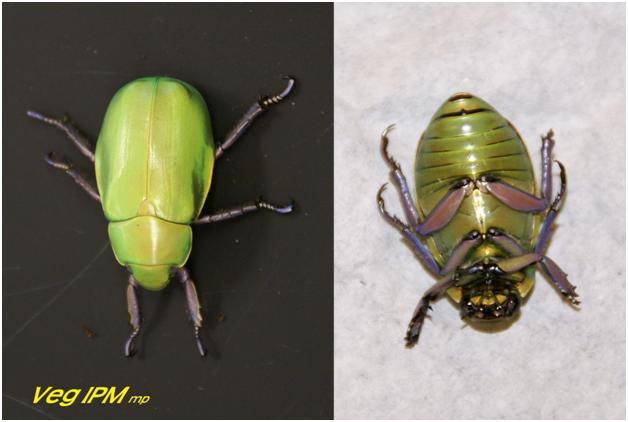 |
|
|
|

|
|||
| |
|||
The common name jewel beetle refers to the large group of scarab beetles in the genus Chrysina (used to be Plusiotis). The shiny color reflection on their elytra (fore-wing), mostly green some are silver or gold, earns themselves the beautiful name I chose Santa Rita Mountains as my destination for my first trip of Chrysina exploration, simply because this place is one of the very few locations that you can see three of the Arizona Chrysina species together in one night. This area is also one of the legendary habitats not only for bird watching naturalists but also for beetle collectors. I set up a black light and a HID light in one of the parking area of the valley about 5000 ft elevation, two lights were 10 meters apart from each other. Twenty minutes after 8pm, the first jewel beetle, Chrysina gloriosa, landed on the ground near the HID light. This shining green colored beetle with silver striped on its back totally explains why they are called jewel beetles. In fact, C. gloriosa is the most common Chrysina species of North America where it distributes in the mountains of S.E. AZ, S. New Mexico, and S.W. Texas. Before this beetle arrived, hundreds of other beetles have already occupied my white sheets under the lights, most of them are in the family Cerambycidae and Scarabaeidae. Chrysina gloriosa While I was checking on the first jewel beetle ever in my life, a second species C. lecontei arrived! This male C. lecontei is relatively smaller than C. gloriosa (1 inch long), which has dark green body and red legs, lack of silver striped on the elytra makes this species seemly less attractive than C. gloriosa. Chrysina lecontei‘s distribution in Arizona is as widespread as C. gloriosa but less common in most of area. The next two hours both my HID and black light were attacked by a crowd of Chrysina beetles, including the 3rd species C. beyeri. This species is the largest jewel beetle in North America (~1.5 inch) and the apple green elytra with purple legs match perfectly on this spectacular beetle. The distribution of C. beyeri is limited to certain mountain ranges in the southern most Arizona such as Huachuca Mountains, Patagonia Mountains, and Santa Rita Mountains. Limited distribution makes C. beyeri more desirable and mysterious among beetle hobbyists. However, in a warm summer night C. beyeri may come to the black light as abundant as C. gloriosa if you are in the right habitat! Although Chrysina jewel beetles are still quite abundant in Arizona sky islands, they are facing heavily and overly collected due to their commercial value. Further research on their biology and ecology should be conducted in the future and the act of protection for these beautiful insects may be considered. Chrysina beyeri
A Probable Case of Glyphosate Resistant (GR) Palmer Amaranth in Arizona A probable case of glyphosate (Roundup) resistant Palmer amaranth (i.e., carelessweed or pigweed) has been discovered in Arizona although seed collection and testing are needed to confirm this conclusion. Resistance occurred in no-till cotton where glyphosate was the only herbicide used. What can we do?
Consequences The challenge of limiting the spread of glyphosate-resistant (GR) Palmer amaranth is great. It can be managed in cotton using a diversity of herbicide mechanisms of action and weed control practices. However, cotton growers with GR Palmer amaranth infestations will face greater weed control costs, will be using herbicides and control techniques that require greater management input, will be using hand labor to remove Palmer amaranth escapes and will likely have to use more in-season tillage for weed control. If you are suspicious of any similar situation or need help, call or email one of the UA faculty listed below: To contact Marco Peña go to: marcop@ag.arizona.edu
|
|||
| Back | |||
For questions or comments on any of the topics please contact Marco Pena at the Yuma Agricultural Center. |
|||
| Home | Cotton
| Veggies | Forages
| Grains | Citrus
| Crop x Crop Insects | Diseases| Weeds | Pesticides | Economics | News | Weather | Research | Photos | Contacts | General Info. Copyright © 2001 University of Arizona, College of Agriculture and Life Sciences Webmaster: Al Fournier (acis@ag.arizona.edu) |
|||


